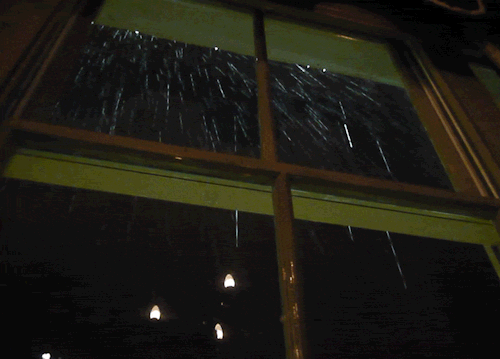Don't wanna be here? Send us removal request.
Text
Why do I become sleepy after eating?
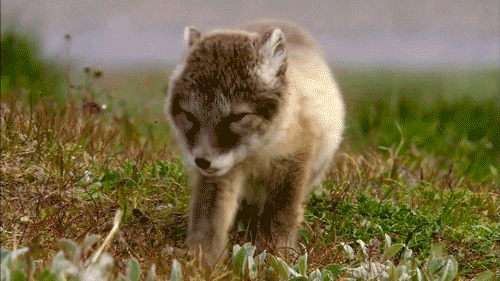
youtube
o The autonomic system (which controls involuntary action of the body, organs and glands etc.) comprises of the sympathetic nervous system (SNS) and the parasympathetic nervous system (PNS). *
o The SNS works via a fight or flight response - a primitive stress response when we faced danger by predators. Noradrenaline and adrenaline are catecholamines released by the adrenal gland which works by increasing the heart rate, respiratory rate, dilation of blood vessels in muscles, pupillary dilatation, slowing down of digestion etc. (see the picture below) It has a thoracolumbar outflow T1 to L2/3.
o The PNS works via a rest and digest response - a response when we are relaxed and calm. It has craniosacral outflow - the cranial nerves and S2-4 (the pelvic splanchnic nerves)
o Eating a meal stimulates more bloodflow to the digestive system and stimulates the PNS.
o Eating carbohydrates stimulates insulin production - the hormone that turns sugar into energy. Insulin also drives protein out of the bloodstream into cells. Some proteins however remain in the blood - such as tryptophan and albumin. There is now less competition for tryptophan to cross the blood-brain barrier to hit the brain and make melatonin - a hormone that regulates sleep and serotonin - its precursor.
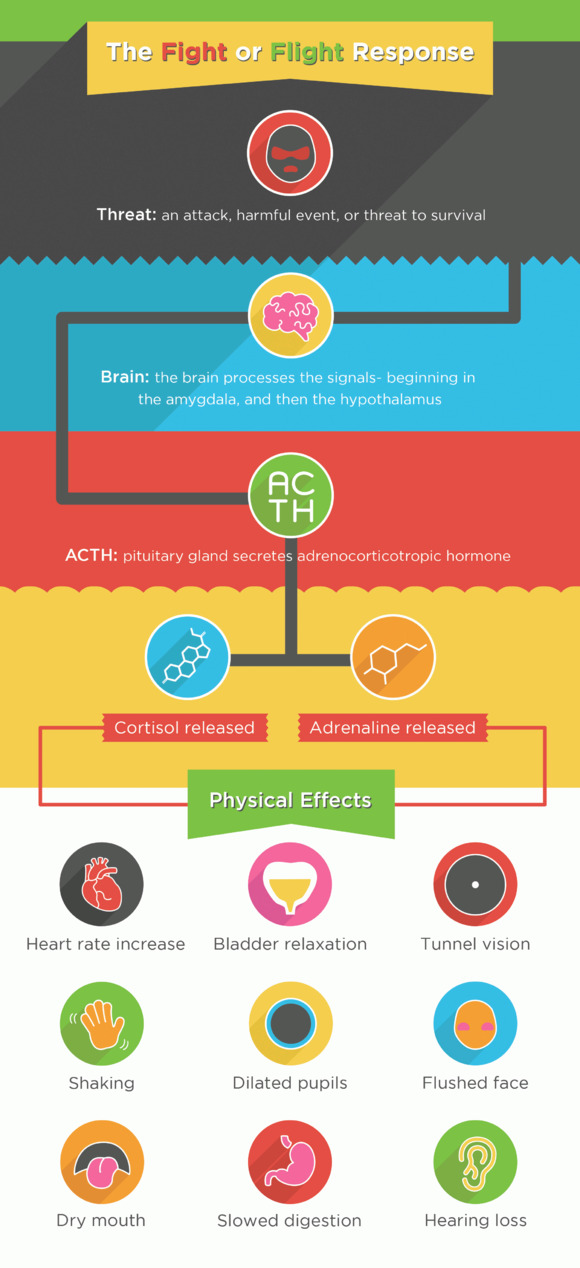
* the autonomic nervous system also comprises of the enteric nervous system which controls the workings of the gastrointestinal tract.
References
https://www.webmd.com/food-recipes/features/the-truth-about-tryptophan#1
These two Crash Course videos are excellent:
https://youtu.be/0IDgBlCHVsA
https://youtu.be/qqU-VjqjczE
12 notes
·
View notes
Text
Why do my ears pop?
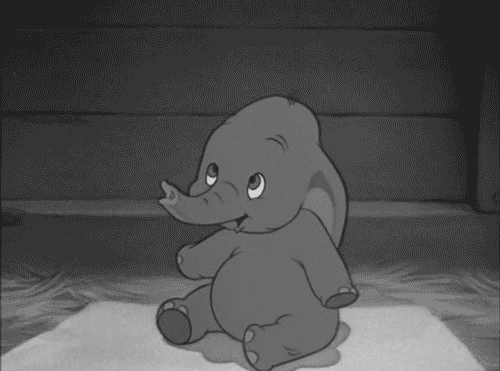
youtube
o Normally the air pressure is the same in the outer ear and the middle ear. The eardrum provides a seal between the two chambers.
o When flying however, there are fewer air molecules in the atmosphere. Therefore the pressure in the outer ear is lower, but the pressure in the middle ear stays the same.
o Extra pressure in the middle ear pushes more on the eardrum causing it to bulge out - this is the stuffy feeling we experience. As it is stretched, eardrum is unable to transmit sounds normally.
o Techniques such as chewing gum, yawning etc. the Eustachian tube opens so the middle ear can have the same pressure as the aeroplane cabin.
o Air rushing to or from the ear and the eardrum adjusting causes this popping sound.
5 notes
·
View notes
Text
Why does meditation work?

Here’s a ASAP Science video on the benefits of meditation
youtube
o Meditation leads to decreased anxiety and depression, and increased pain tolerance.
o Mediation has been found to increase memory, self-awareness and goal setting, improved immunity
o Meditators have higher levels of alpha waves (9-13 Hz) - reduce negative mood, tension and anger
o Grey matter is more dense in the cortex - responsible for higher order brain functions, and less dense in amygdala (stress and emotion centre) and meditation counteracts the shrinkage of grey matter during ageing.
Meditation as mentioned in the above video (and many more in the Further Reading section) has several benefits - a mental training for the brain. But why does it actually work? Thus far, the exact mechanisms are still unknown but there are theories in recent years that give a better picture of how meditation works on the brain. The most probable effect on the brain is stimulating the autonomic parasympathetic response (rest and digest) rather than the sympathetic response (fight or flight). Until further research in neuroscience, we will not know exactly what triggers off a parasympathetic response but it is likely similar to theories regarding sympathetic responses which have been developed due to our evolutionary responses to hunt and flee.The parasympathetic response has the following effects on the body: SSLUDD - sexual arousal, salivation, lacrimation, urination, defection, digestion. The PSNS response also leads to a reduction of stress hormones such as catecholamines and cortisol, the slowing down of the heart rate and lower blood pressure.
Mentioned earlier was how meditation tunes the brainwaves towards an alpha wave predominance. See Figure 1 for a brief overview of the different brainwaves. The differences are all to do with different electrical activity in the brain and the different frequencies transmitted according to the different type of activity performed.
Figure 1: Brainwaves seen on EEG
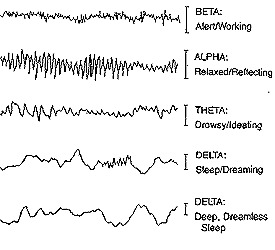
There’s still a lot of holes in the knowledge of the exact details why but from this information we can say that meditation taps into brain activity associated with relaxation hence leading to a parasympathetic response - or is it vice versa? Either way, the science shows it works - we may not know why exactly it works but no doubt further research will give us more answers. Interestingly David Nutt, psychiatric professor at Imperial has recently published research showing that meditation has similar effects to certain hallucinogenic drugs - in this example, Ayahuasca a South American hallucinogen with LSD like effects. This has been shown with brain imaging such as fMRI and EEG. After attending a recent talk by David Nutt, he elaborated on this link where both meditation and hallucinogenic drugs dampen down brain activity in the brain. This sounds counter-intuitive but it makes sense if you think of it like an overheated computer (which our busy minds are) and a reset button. And excitingly this isn’t just a temporary relaxation, meditation can actually rewire our brains with structural and neurophysiological changes.
Figure 2: Beta wave activity in brains before and after meditation
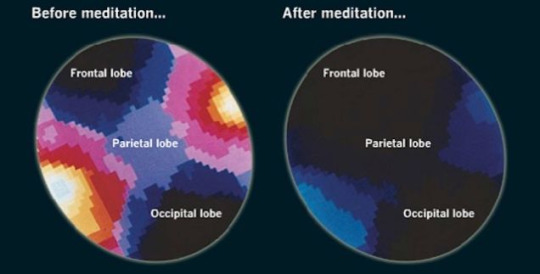
So far, we have an good idea of how meditation works but it is an area ripe for future research especially with the correlation with hallucinogens. The next few years will provide us with more answers no doubt.
I cannot emphasise enough how important meditation is. Modern life is rubbish. Living in the city, busy people. deadlines, commuting - stress is inevitable. We weren’t meant to function like this - we’re not machines. In recent years, meditation has boomed in popularity in the west (mainly due to yuppie cultural appropriation). However what thousands of years of wisdom gives to our daily lives is the key to confronting with the negative aspects of life fuelled by stress. Meditation can be thought of as an exotic, fabled practice an abstract supernatural ritual described in Herman Hesse’s Siddartha or in Frank Herbert’s Dune or George Lucas’ Star Wars. But in reality it is astonishingly simple, sitting or standing, on the tube or at home, it can be practised anywhere and anytime. There are many different types ranging from mindfulness of breathing to metta bhavana. But all with a purpose of acceptance. Only through acceptance instead of resistance will tension dissolve. In Yuval Noah Harari’s excellent book Sapiens: A Brief History of Humankind (which by the way I cannot recommend strongly enough - read it!) in pages 441-442 gives the best explanation for meditation I’ve found.
People are liberated from suffering not when they experience this or that fleeting pleasure, but rather when they understand the impermanent nature of all their feelings, and stop craving them. This is the aim of Buddhist meditation practices. In meditation you are supposed to closely observe your mind and body, witness the ceaseless arising and passing of all your feelings, and realise how pointless it is to pursue them. When this pursuit stops, the mind becomes very relaxed, clear and satisfied. All kinds of feelings go on arising - joy, anger, boredom, lust - but once you stop craving particular feelings, you can just accept them for what they are. You live in the present moment instead of fantasising about what might have been.
Sapiens: A Brief History of Humankind - Yuval Noah Harari
I’d highly recommend using headspace though there are other apps such as calm and stop, think & breathe. The key part of meditation is the daily consistency. It’s like studying for an exam consistently everyday vs cramming the night before. This practice of meditation serves as a microcosm of getting sh*t done in life.
For me personally, I’ve had my fair share of struggles like everyone else. Depression, feuds, worries, anxiety, stresses, death, grief. Life isn’t easy, but isn’t that the whole point?! No diamond ever become a diamond without pressure. No one ever achieved anything without hard graft.
"Easy choices, hard life. Hard choices, easy life." - Jerzy Gregorek
If you can meet with Triumph and Disaster
And treat those two impostors just the same;
If - Rudyard Kipling
Marcus Aurelius, the great Roman Emperor in his famous and aptly named Meditations was and still is the most famous face of stoicism, an ancient Greek school of philosophy defined by their superhuman quality of indifference to the vicissitudes of fortune and to pleasure and pain, expressed this truth over a millennium ago
You have power over your mind - not outside events. Realise this, and you will find strength.
Meditations - Marcus Aurelius
Now doesn’t that sound uncannily like meditation? Now shall we all just appreciate how wonderful it is to simply be present.
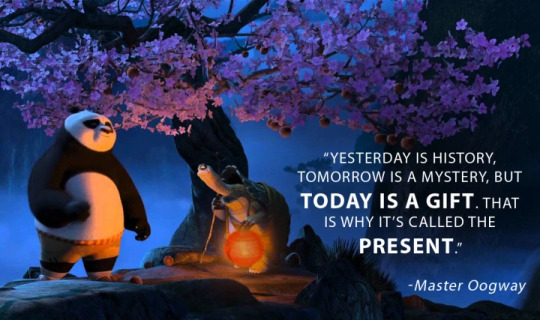
Further reading
https://www.youtube.com/watch?v=jH7WoeBVtXY
https://www.youtube.com/watch?v=yZY-TH4KHlg
https://www.youtube.com/watch?v=LkoOCw_tp1I
https://www.youtube.com/watch?v=q0DMYs4b2Yw
https://www.youtube.com/watch?v=FAcTIrA2Qhk
https://www.youtube.com/watch?v=wirV265ZYSw
https://www.youtube.com/watch?v=qzR62JJCMBQ
http://www.freemeditation.com/meditation-basics/how-does-meditation-work/
https://www.scientificamerican.com/article/what-is-the-function-of-t-1997-12-22/
http://metro.co.uk/2017/04/05/taking-hallucinogenic-drugs-has-similar-effects-to-meditation-on-the-brain-6554913/
http://yang-sheng.com/?p=10991
https://en.wikipedia.org/wiki/Brain_activity_and_meditation
https://www.headspace.com/
https://www.calm.com/
https://www.stopbreathethink.com/
5 notes
·
View notes
Text
Why are chemotherapy and radiotherapy used in cancer?
youtube
o Chemotherapy uses anti-cancer chemicals for treatment of the whole body (metastasis). Can be administered through injection, intra-arterial, intra-venous, topical or orally. Long course treatment schedule (weeks to months). More expensive.
o Radiotherapy uses ionising radiation for treatment of a specific area of the body. Can be administered through external or internal injection and orally. Treatment schedule depends on severity. Cheaper than chemotherapy.
Side effects in both include fatigue, hair loss, lower immunity.
http://www.differencebetween.com/difference-between-chemotherapy-and-vs-radiotherapy/
2 notes
·
View notes
Text
Why is tape sticky?
youtube
o viscoelastic property - properties of both a solid and a liquid
o fluid properties of van der Waals bonds and electrostatic attraction (with dipoles in solids) make tape sticky
1 note
·
View note
Text
Why do suction cups stick?
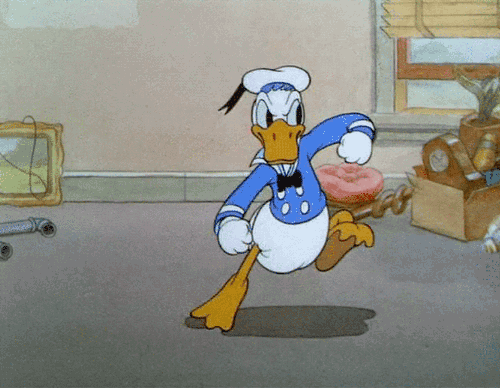
Suction cups for use in cars are now everyday objects with uses of holding your GPS navigator or smartphone. But how do they actually work?
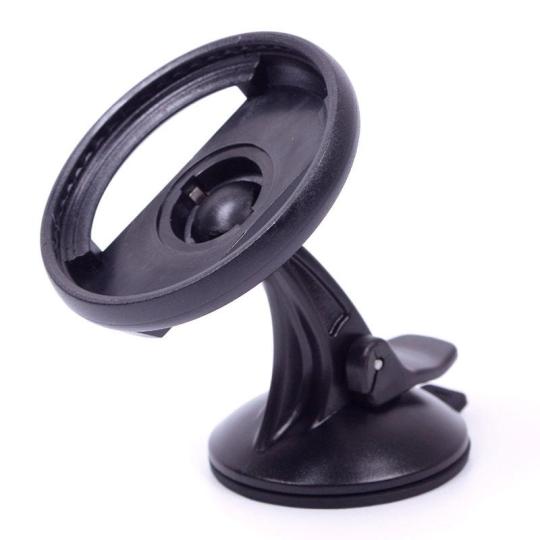
In scientific terms, gravity and friction are the two main forces that make it possible for suction cups to work. Gravity pulls the molecules in the air toward earth, creating atmospheric pressure of roughly 14.7 pounds per square inch at sea level. A good cup on a slick surface causes that pressure to be applied to the outside of the cup, pushing it down onto the surface. Friction keeps the cup from sliding.
The principle of pressure: P =F/A
P = pressure
F = Force
A = Area
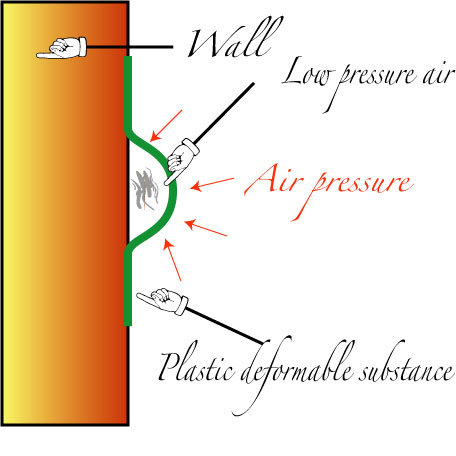
When suction cups are pressed against the car window, the air inside it is pushed out hence eliminating the pressure inside the cup and forming a partial vacuum which seals the cup tightly with no air allowing to come in. This is because the pressure of the cup is lower than outside, when the air pressure drops (i.e. opening the cup) then the air pressure on the outside becomes lower than inside.
The above equation can be reformed to a Force formula (F=AP) where the higher the area, the greater the force - hence bigger suction cups are more sticky.
youtube
Further reading:
https://www.youtube.com/watch?v=6_aQfFrcP6M
https://suctioncups.com/pages/suction-cups-101
1 note
·
View note
Text
Why does hair go lighter in the sun?

Hair is a collection of dead cells hence when the UV radiation in sun bleaches and oxidising the melanin (the pigment cells in cells) in the hair into a colourless compound hence giving a lighter appearance with no ability to produce any more melanin. (Previously it was thought that the outermost layer of skin was dead but since this has been proven not to be the case - hence when sun shines on skin - they can make more melanin hence a darker appearance with a tan.)
Also check out the links for more information about skin and the sun:
http://genetics.thetech.org/ask/ask180
https://www.sharecare.com/health/healthy-skin/is-outermost-skin-layer-dead
2 notes
·
View notes
Text
Why does hair go darker when wet?

This is all due to light striking an object (in this case - hair) and the light reflecting back into our eyes to give the illusion of colour. Some of this light is absorbed by the pigment of the hair.
In wet hair, the light reflecting off the surface of the wet hair reflects back to the inside surface of the water film where it is reflected back onto the hair again (total internal reflection) thus creating another chance for the light to be absorbed making the hair appear darker. Wet hair also clumps together with the hair strands coming closer together (electrostatic properties of water) which allows for less reflection off the hair and for more absorption.
For a better explanation check out the video below:
youtube
http://www.sciencefocus.com/qa/why-does-hair-get-darker-when-wet
http://wonderopolis.org/wonder/why-does-your-hair-look-darker-when-its-wet
https://www.thenakedscientists.com/forum/index.php?topic=9494.0
1 note
·
View note
Video
youtube
o involuntary spasm of the diaphragm causes closure of the vocal cords
o inhalation of air by spasm of diaphragm prevented by closure of the opening of the vocal cords (glottis) - causes hic sound
1 note
·
View note
Text
Why do anti-histamines make you sleepy?
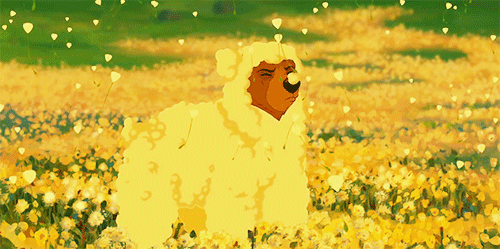
It’s hayfever season again and the pollen count is particularly high this year. For hayfever sufferers there’s a fine line we tread of sneezing non-stop or being bunged up on anti-histamines which have the unfortunate side effect of making you tired. In fact many sleeping aids use antihistamines for this very purpose.
So why do anti-histamines make you tired? First of all, an anti-histamine is a type of drug that opposes the activity of the histamine receptors in the body. There are 4 different types of histamine receptor - the relevant histamine receptor we will discuss involved in allergy is the H1 receptor.
Histamines are nitrogenous compounds in our bodies involved in local immune functions and inflammatory responses with a central response in causing an itch (which is why we itch during an allergy).
Histamines are released when our immune systems detect a potentially dangerous foreign substance (an allergen) which triggers the release of white blood cells (cells that protect the body from infection): basophils - released in allergic response, and eosinophils - released in parasitic infections and in allergic response, and mast cells - a type of white cell which contain histamine that seek out cells with a histamine receptor.
Histamines induce an inflammatory response which: dilates blood vessels increasing the blood flow to the site of the injury. The blood vessels also become more permeable which allows proteins and white blood cells to seep into the damaged or infected tissue. It is these histamines that cause the symptoms associated with allergies: sneezing, itch (pruritus), chest congestion, wheezing.
These mast cells in the first instance of contact with an allergen become primed by releasing IgE which by the second time of contact with an allergen leads to the release of histamine. (see Figure 1)
Histamine release occurs when allergens (such as pollen in hayfever) bind to these mast cell bound IgE antibodies (immunoglobins = antibodies) which leads to the degranulation of the mast cells. IgE antibodies are the immunoglobulins involved in Type 1 hypersensitivity (immediate hypersensitivity) which is an allergic reaction provoked by re-exposure to an allergen.
Figure 1: IgE - Type 1 hypersensitivity
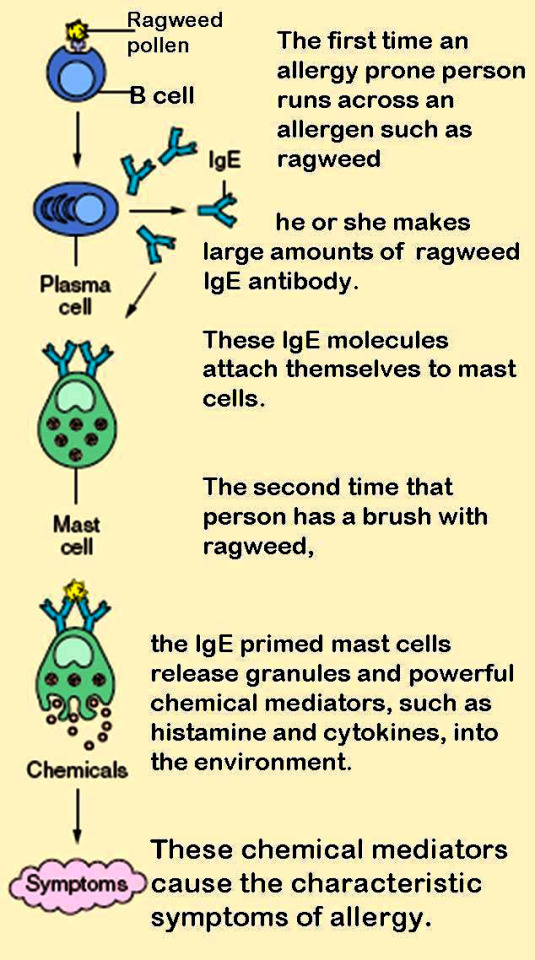
Anti-histamines work by blocking the the attachment of histamines to their receptors hence preventing them from carrying out their functions.
To understand why anti-histamines cause drowsiness firstly we need to understand the actions of histamines. (Figure 2 - stolen from wikipedia)
Figure 2: Function of Histamine
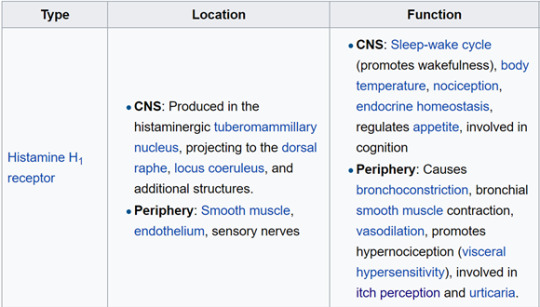
As you can see sleep-wake cycle is regulated by histamine - it is this disruption of histamine by anti-histamines by crossing the blood-brain barrier that leads to sleepiness. There is this property in all anti-histamines even in those marketed as non-drowsy - the effect is reduced somewhat but not entirely avoidable.
Popular types of antihistamine include:
Cetrizine
Chlorphenamine
Loratadine
References
https://www.livescience.com/41999-antihistamines-drowsy-benadryl-allergies.html
http://universityhealthnews.com/daily/energy/the-myth-of-non-drowsy-allergy-medication/
3 notes
·
View notes
Text
Why does milk help when eating curry?


After countless times of eating out at a South Asian restaurant and burning my tongue eating inedible curry, I was often ushered towards so milk (I can’t have it, I’m lactose intolerant). But it left me wondering why is milk a better beverage for soothing the aftereffect of spice than say water or a beer?
The answer lies in the composition of spice: capsaicin which is the basic component of chillies and is basically an irritant - producing a burning sensation to anything it comes into contact with. Basically spice isn’t a taste at all, it’s pain.
First of all let’s learn how taste is detected. That tongue map you learnt in school? It’s wrong! Taste is detected from every region in our tongue. Taste is the chemical sense perceived by specialised receptor cells that make up taste buds and Flavour is a mixture of different senses - here spice/pain comes into play.

Within the tongue, there are chemoreceptors that can detect taste called gustatory receptor cells.
One taste bud is comprised of 50 of these cells. They are contained in goblet shaped papillae which help create friction between food and the tongue. Every gustatory receptor cell contains a gustatory hair which is key in detecting taste when food molecules mix with saliva and enter the taste pore. The gustatory receptor cell then synapses with neurons and passes the electrical impulses to the gustatory area of the cerebral cortex which the brain interprets as taste.
“Taste” refers to the five primary tastes:
sweet
sour
salty
bitter
umami (savory seaweed taste found in meat and tomatoes etc.
Spice doesn’t comprise of these five and as mentioned is detected as a pain. This pain is also the reason why spice is addictive, the capsaicin molecules from the spice activate the pain receptors - releasing a number of calcium ions to trigger off the neurotransmitters signalling to the brain to release endorphins to dampen down the pain and heat. People literally get addicted to this. And yes, as the eager eyed of you may have noticed in the chart - there is literally a scoring system based on spice! The Scorville rating. (I wonder what an extra hot in Nando’s would score?)
Even one of my colleagues is part of this craze for spice, courtesy from everybody’s favourite tabloid pretending to be a broadsheet:
http://www.dailymail.co.uk/news/article-2257120/Doctor-eats-curry-hot-known-The-Widower-chefs-making-wear-goggles-face-mask.html
This guy had hallucinations?! This can be explained by the cannabinoid substances in Spice act on the THC receptors of the brain and central nervous system. The drugs in Spice are much more powerful and unpredictable than marijuana, and potentially more toxic. This is why Spice can cause a high similar to that of marijuana.
So here lies the question, why does milk help? We’ve heard of the various theories - curry being acidic, milk being alkali etc. (first of all, milk is slightly acidic anyway). Thus this means we need to search for a better answer.This is because of the properties of firstly milk and secondly the properties of capsaicin. (*Also we are talking about cow’s milk in this post - as we shall find out, non dairy milk derivatives aren’t effective)
Firstly milk is a fat - quoted from wikipedia (sorry) “an emulsion or colloid of butterfat globules within a water based fluid that contains dissolved carbohydrates and protein aggregates with minerals.” One of the largest components of milk is CASEIN which make up the majority of the protein in dairy milk and forms curds in out of date milk. Non dairy milk such as coconut milk and almond milk etc. do not contain casein.

Here is an approximate structure of casein - it’s difficult to get the exact structure and composition given the different sources of milk etc. As we can see here the prominent NONPOLAR hydrocarbon heavy side chain.

Capsaicin as seen here with its chemical structure has a long hydrocarbon tail on the right which means it binds strongly to lipoprotein receptors on the tongue.Let’s explain the chemistry a little: hydrocarbons are NONPOLAR which means there is even distribution between the electrons and protons in the the molecule.
This means that casein and capasaicin are both NONPOLAR - this means that they are able to be dissolved in one another. This is the concept of LIKE DISSOLVING LIKE.
This explains why water is ineffective in treating the curry scolds - water is POLAR - H20 and the same logic applies: polar substances tend to dissolve in polar solvents

References
https://en.wikipedia.org/wiki/Casein#Medical_and_dental_uses
https://en.wikipedia.org/wiki/Milk
https://www.acs.org/content/acs/en/education/resources/highschool/chemmatters/past-issues/archive-2013-2014/peppers.html
http://www.chemicalbook.com/ChemicalProductProperty_EN_CB3189234.htm
http://krs-the31st.blogspot.co.uk/2013_06_01_archive.html
http://www.betacasein.org/index.php
2 notes
·
View notes
